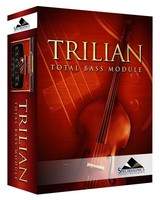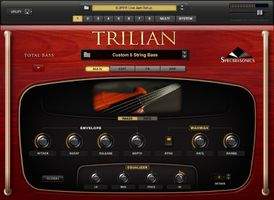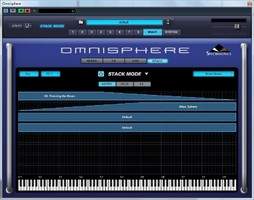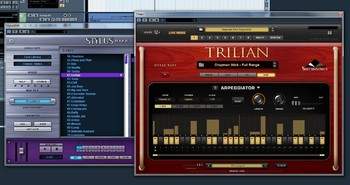Spectrasonics has been living a love story with bass guitars for sixteen years. A long time before Omnisphere, Stylus and the famous Distorted Reality, one of the first products developed by Eric Persing and his team was Bass Legends – a sample bank CD dedicated to three of the most renown bass players on earth: Marcus Miller, John Patitucci and Abraham Laboriel.
When it comes to virtual bass, the manufacturer struck a decisive blow in 2002 with Trilogy. Based on the UVI Engine from Ultimate Sound Bank (the same audio engine used on Plugsound and MOTU’s MachFive) and an enormous sample bank (for those days: 3 GB), Trilogy quickly became the market’s reference in its category. The reasons for its success were the careful and accurate sampling and the huge sound it provided – Spectrasonics’ hallmark – but, above all, a versatility competitors couldn’t keep up with. Modern, vintage, acoustic, electric, or synth bass sounds combined with finger, pick and slap playing techniques: it had just about everything, including a wonderful double bass. There were people who preferred the sound character of the Quantum Leap Hardcore Bass (vintage to distorted sharp sounds adequate for rock, industrial and big beat music) or Scarbee’s detailed and plastic bass sound, yet there was no choice but to accept that no competitor could offer such versatility/quality ratio as Trilogy did. However useful to program convincing bass parts (thanks to the True Staccato programs that provide hold notes for the four lowest octaves and staccato notes for the four higher octaves in the same patch), Trilogy wasn’t perfect: some criticized its lack of character while others didn’t like the “oversized” sound of the instruments, which was stunning for solo parts but too big for a full mix…
When compared to the latest Scarbee or Pettinhouse products, it’s obvious that Trilogy cannot conceal its age, from a technical point of view. That’s why we are very happy to welcome Trilian.
Big Mama
The good news is Trilian’s sound bank includes more than 21,000 samples just for the upright bass alone! All in all there are ten times more samples than its predecessor. Incredible. Apart from all the samples included in Trilogy, which guarantee full compatibility with your previous projects, you also get a plethora of new instruments for a total of 1,290 patches! It has every possible electric bass, from Fender to Music Man, Yamaha, Epiphone, Lakland, and Fodera; the synth bass category increased to 333 sounds taken from the best synthesizers of the last 50 years: Novation Bass Station, Yamaha CS-80, Cwejman Modular, Moog Minimoog, Little Phatty, Voyager & Taurus, Korg MS-20, Oberheim, ARP 2600, Roland Juno 60/106, Waldorf Pulse, DSI Mopho & Tetra, Roland TB-303, SH-101, Metasonix KV-100 Assblaster, SE-1, Omega, ATC-1, etc. And that’s it? Not quite! Spectrasonics also added a Chapman stick plus all instruments included in its good old Bass Legends, as well as – we kept the best for last – two new double basses that got special attention from the manufacturer with up to twelve velocity layers, 12x round robin and an absolutely jaw-dropping sound.
Weak Systems Strain…
| And Then There Was Lite |
| Trilian uses Hard Disc Streaming to read samples, the software requires a large amount of RAM to work properly. To solve it, Spectrasonics provides ‘Lite’ versions of the patches with many options that you can access through the ‘System’ panel or the ‘Lite Version Options’ Panel. Here you can define the maximum amount of RAM allocated to the software, define the round robin level or deactivate it, switch off the legato… But, the most interesting feature is the ability to reduce the samples used by a patch according a velocity range : you can decide to not use the samples beyond or bellow a velocity value. Because the bass is often heavily compressed in the mix, it’s a smart way to reduce the RAM consumption. But we have to be clear : it works perfectly with a bass sitting in the mix of a rock song, but it’s far less interesting when you want to achieve a beautiful solo with an Upright Bass Model, because the missing velocities causes a certain lack of expression. Furthermore, because the UpRight Bass Patches are the biggest in the sound bank, just be aware that if you want to obtain the best of what Trilian has to offer, you need 4 Gb of RAM, or more if you plan to use it with some other virtual instruments. |
Every rose has its thorns! The features provided require a very powerful computer system with at least 4 GB RAM. It’s a lot compared with Omnisphere, the manufacturer’s flagship, which only requires a minimum of 2 GB RAM. The system requirements are understandable when you consider that each patch needs 1 to 2.3 GB RAM or up to 3.3 GB in the case of double basses and multi-patches. Nevertheless, we were surprised by the amount of resources needed. The sole idea of having to use Trilian in a full mix along other heavyweights like BFD, East West’s Symphonic Orchestra or the Ivory Grand Pianos frightened us… What’s more, the fact that the product packaging indicates that it needs 4 GB RAM under Windows XP/Vista/Seven 32 or 64 bit systems is confusing since, as far as we know, Microsoft’s 32-bit systems cannot handle more than 3 GB RAM.
I first tried to install the software under Windows XP 32 bits with 3 GB RAM. I was able to load many patches but there were some others, like the double basses, that were unavailable (the loading process started but wouldn’t complete). So I went to the nearest computer store to upgrade my system to 6 GB RAM and I also updated to Windows Seven 64 bits. I had to reinstall Cubase 5.1 and the drivers of my Echo Gina3G. Finally, my system was Trilian compliant…
The installation of all five DVDs was a bit long but smooth. Once the online authorization process was complete, the software update to version 1.2 beta ran in three steps: one patch for the software, one for the presets and one for the sample bank. Everything worked fine even if somewhat elaborate: a single patch would be much more user friendly…
As part of the installation process, we also have to mention that there’s no Trilian standalone version provided, so you can only use it as a VSTi, AU or RTAS plugin within a host application. Is there any documentation? The printed document provided only describes the installation process. The real user’s guide is not a PDF file but an HTML help menu within Trilian accessible via your Internet browser. The manual is very comprehensive and describes every single function but don’t expect to learn anything about how to program a bass part. However, we are sure that Spectrasonics will soon provide some sort of video tutorials as always.
Omnisphere for Bass
Users of Spectrasonics’ instruments, and especially Omnisphere, will have no problem to get started. In spite of its nice, wood-like GUI that recalls a double bass, the interface is inspired on Omnisphere, specially the preset manager. The latter provides a search engine and an effective tag set (you can sort the presets by instrument type, instrument, playing style, articulations, etc.) that allow you to use your own tags or display the developer notes about each patch. As a summary, the manager is well thought-out and that’s a good thing because Trilian’s – like Omnisphere’s – sound bank is based on a very complex architecture.
At the top of this sophisticated structure, you’ll find the Multi, which is a kind a super patch including up to eight parts and four racks for aux effects and a master FX rack. You have four screens to edit multi-patches: Mixer to mix the different parts of the multi, FX to control the effect racks, Live to switch between several parts (via a keyswitch system), and Stack to manage keyboard splits or the volume between different parts (allowing progressive overlaps). One level below you’ll find Parts, which are single instrument patches (for example Staccato, Sustain, Vibrato) that can be loaded into one of the eight Multi slots. This layer also has four screens: Arp (a 32-step arpeggiator/sequencer), FX (with four insert effects) and Edit – which like in Omnisphere, consists of an improved version of the old UVI Engine interface – with a modulation matrix, a multimode filter, six LFOs, and four envelopes. Didn’t you say four screens? Right. We still have Main left.
This new feature allows you to group all Main parameters of a patch within a single screen like in Kontakt or Reason’s Combinator. This fully configurable window makes life much easier for all users. Just right click to add or suppress a knob, a unipolar or bipolar control (the latter has zero as a center value) and to assign it to any parameter. You can even edit its name. In fact, you can adjust the user interface to your needs, freely adding and naming knobs like an on/off switch for an effect or a knob for the cutoff frequency of a filter.
Let’s go back to the sound structure: every part is made up of two layers, each of which has its own Edit window with FX section and the Soundsources, which are the sample banks comprising the MIDI mapping of the sounds (pitch, velocity, etc.) as well as the tags and other meta information about the samples. In other words, you’ll find here everything about the instrument except for effects and modulations. To summarize, this architecture might be too elaborate for people who just want a basic bass sound, but it provides you with very comprehensive editing and sound design possibilities. And we didn’t even mention the overlapping of FX sections nor the numerous modulation functions. The possibility to change the Soundsource of a patch without affecting its other settings guarantees hours of experimentation: How would the Hardcore Bass sound with a wah and a fuzz combined with a double bass sound? One click and you’ll find out. And the best of all is that the results are quite interesting…
Ok, But Does the Software Sound Good?
Yes. Very good. Too good! We didn’t expect anything else from one of the best sound designer teams in the world: the first minutes you spend with the instrument are shocking – Trilogy seems to be an antique compared with Trilian. There are several reasons for that, including the tenfold bigger sample bank and the size of single patches.
The first audible improvement is the Round Robin technology. What’s that you say? No, it’s not Batman’s pal in pantyhose, it’s a technology that consists in alternating several samples of the same note and velocity so that repeated notes sound more authentic. Trilian uses up to six samples of a single note in order to achieve that. The round robin technology works in sequential mode (always the same playing order), in random mode (random notes) or in random cycle (random sequences for each cycle). In comparison, Trilogy only offered a True Staccato mode which allowed you to create a 2x round robin. Listen to the result with the Rock P-Bass patch, first without round robin and then with the double bass patch with 6x round robin:

- noroundrobin pbass dry00:11
- roundrobin pbass dry00:11
- roundrobin upright dry00:11
Another new feature is the Dynamic Legato function to play trills and hammers/pull-offs easily: when you hold a note, the upper and lower semitones and tones allow you to make hammers/pull-offs. It is very intuitive and adds a lot to the part, which is why we regret that the function is limited to only two tones. For more possibilities, you still have to use the Solo mode, like in Trilogy, or the Glide mode but the results won’t be fully satisfying.
Here is a trill made with the Rock P-Bass patch:

And here is a down slide using the Dynamic Legato function first and then attacking all notes:

For the sake of comparison, here is the same sequence played with Trilogy’s Rock Picked Bass:

Impossible not to like better the first example, isn’t it?
Trilian, obviously, provides more velocity levels than its predecessor. Once again, this is a great improvement compared to Trilogy, even though velocity steps are still audible with most instruments:

- vlocitroundrobin pbass dry00:08
- vlocitroundrobin upright dry00:08
But it doesn’t really matter since bass guitars are usually highly compressed in a mixdown…
Among all the details that seem insignificant but make a programmed bass part sound authentic, Spectrasonics added release noise to each note and created programs dedicated to slides (upwards and downwards), making them available for all notes, instead of being only special effects. It’s a real delight to play a Multi in real time, but also to program parts like this:

Huge Versatility
As I already mentioned in the beginning of this review, the sound bank doesn’t miss a thing: besides the plethora of high-quality bass synths, you get a much wider sound range than in Trilogy. It undoubtedly has to do with the sampled instruments, ranging from a vintage bass to a Chapman stick, a Precision Bass, a Jazz Bass, or a double bass, but it most certainly has to do with the fact that each bass has been simultaneously recorded via a DI box and an amp (which one? We don’t know…). People who thought Trilogy sounded too clean will enjoy the possibility Trilian offers to mix both signals freely in order to get lots of sounds ranging from very dirty to perfectly clean. Listen to this bass with Amp at 100% and Pickup at 0%:

Now the same bass with Amp at 0% and Pickup at 100%:

Double basses also benefit from this, however the Pickup sounds very electric and the amp is replaced by a U-147 mic that gives a lot of air to the instrument.
Add all the FX sections and you’ll get an idea of the possibilities at hand…
Effects
Most effects sound very good but it seems they are all taken from Omnisphere and weren’t developed specially for bass guitar. Besides flanger, phaser, chorus, distortion, compression, and EQ, you get a lot of delay, reverb and even formant effects. We only miss an octaver! Even though you can create the octaver effect yourself by loading the same patch in two different layers with a different pitch, but this will increase the RAM/CPU consumption much more than a simple harmonizer effect loaded as an insert.
Apart from this detail, all effects are quite good and allow you to shape the sound effectively to get different results:

- goodtimes jbass wah00:09
- goodtimes jbass sfx100:09
- goodtimes jbass delay00:09
- goodtimes jbass fuzz00:09
And let’s not forget the huge possibilities provided by the modulation matrix, the multimode filter, the envelopes, and the LFOs you can access from the Edit page.
From this standpoint, Trilian is a real sound design tool rather than just a simple virtual bass guitar, which will surely delight all sound design freaks – who, by the way, will also be pleased to know that Trilian works perfectly with Omnisphere and Stylus RMX.
All patches of Spectrasonics’ virtual bass can be directly loaded into Omnisphere where they can be combined with any Omnisphere sound to create sophisticated mappings.
Listen to the following sound samples. You’ll hear the Trilian patch first, then the Omnisphere patch and finally both patches combined in Omnisphere (I know, the examples are awful but I used only one finger to create them).

- mixomnisphere trilianalone00:52
- mixomnisphere omnialone00:52
- mixomnisphere00:52
As for Stylus, it works wonderfully with Trilian’s arpeggiator: a simple drag and drop allows you to control Trilian’s arpeggiator sequence with the groove of a Stylus loop. Check out the following sound sample:
Groove and arpeggiator without sync:

Arpeggiator controlled by Stylus:

This very powerful and extremely easy-to-use function is a breeze if you need to create music quickly, like composers do for broadcasting. Considering that everything can be loaded into Omnisphere, we could venture to say that these three virtual instruments might be enough to produce extremely good-sounding music with only a couple of keys…
Conclusion
Based on our previous experience with Omnisphere and Trilogy, Trilian is indeed the killer tool we were expecting. Besides the absolutely perfect sample material and its huge editing and processing possibilities, Trilian’s main assets are its amazing versatility and affordable price. True, Native instruments offers Scarbee basses for €89 each providing the same quality as Spectrasonics. But you only get one bass model recorded either via a DI box or an amp. With Trilian you get numerous bass models recorded via a DI box and an amp, a comprehensive bass synth library, a Chapman stick, a double bass, a fretless bass, etc. This software has no direct competitor on the market. Period.
The fact that Trilian works perfectly with Stylus RMX and Omnisphere makes it a must-have for certain musicians. As a former Trilogy user – and lover – I can honestly say that the quality of both programs cannot be compared (Trilogy is eight years older…).
The only con Trilian has are its very high system requirements. You can always lower the quality of the patches or use the the freeze function of your host sequencer if your system is not powerful enough, but it’s still a bit perplexing to see a bass take up so much system resources…
Nonetheless, Mr Persing and his team stroke a decisive blow once again and it will be very difficult to try to compete with them considering the price of the product…
- Very comprehensive bass library
- DI box and amp sound
- All articulations that were missing in Trilogy to create authentic bass parts (hammers, slides, etc.)
- Round Robin function
- Overall sound quality
- Editing and processing possibilities
- Integration in Omnisphere and Stylus
- Wonderful double bass
- Chapman stick – a rarity
- Affordable price
- Too complex for people looking for a simple bass sound
- (Too) high system requirements
- HTML user’s manual without any information on how to program the software




